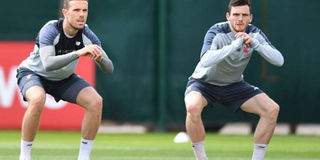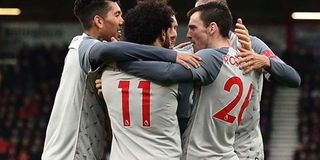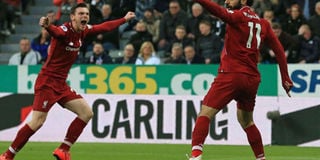Liverpool's Andy Robertson: The people and places behind Scotland defender's rise

Liverpool's English midfielder Jordan Henderson (left) and Liverpool's Scottish defender Andrew Robertson take part in a training session at the Melwood Training ground in Liverpool, northwest England on May 28, 2019. PHOTO | ANTHONY DEVLIN |
What you need to know:
- Robertson signed in the summer of 2017 and made his debut in a 1-0 win at Crystal Palace on 19 August. He won the man of the match award, but that doesn't tell the whole story.
The sun beats down on a small patch of grass. Its rays turn the windows of the surrounding high-rise flats into sheets of gold. The midday heat shimmers. Nothing moves.
This is Maryhill, a working-class district in the north of Glasgow. Fifty years ago, this housing estate was known as 'The Barracks'. It is a place rich in Scottish football history.

Liverpool's Scottish defender Andrew Robertson (right) appeals to English referee Martin Atkinson during their English Premier League match against Leicester City at Anfield on January 30, 2019. PHOTO | PAUL ELLIS |
Charlie Nicholas, one of the best Scottish footballers of his generation, who played with distinction for Celtic and won the 1987 League Cup with Arsenal, grew up here. Next door lived Jim Duffy, an elegant defender who impressed at Greenock Morton, Dundee and Partick Thistle.
As kids in the 1960s and 70s, Duffy and Nicholas dominated football matches in The Barracks. But there was another conspicuous youngster on the scene.
Andy Robertson's father Brian, or 'Pop', lived a corner-kick away in a third-floor flat overlooking their makeshift pitch.
'Pop' was a goal poacher with a tenacious streak the size of Hampden Park. He never missed a game, and never shirked a tackle, despite his huge physical disadvantage.
After sustaining a spinal injury at a young age, he was forced to wear a metal brace stretching from his waist to his neck whenever he kicked a ball around with his childhood friends.
Duffy recalls: "Andy has got his determination, that never-give-up attitude, from his dad. That working-class attitude of rolling your sleeves up, making the most of things and seeing where it takes you.
"There's something in his DNA which has pushed him to his limits."
Andy Robertson is an affable guy. Ask anyone. The Liverpool fans who stop him for selfies in the street. The media department at Liverpool FC who find him to be the most obliging of footballers. The former team-mates and coaches who he works hard to remain in touch with. Look closer, though, and there is a cold-blooded glint in those brown eyes. It hints at an awesome toughness.
John Gallagher coached Robertson at under-14 and under-15 level for Celtic. "As a kid, if someone went over the top on Andy, he would chase them down," he says. "He will not shy away from confrontation. He can do the public face, he always speaks very well. But he is a beast on the pitch."
"Wise, and streetwise," is how former Dundee United team-mate John Rankin puts it.
This is, after all, a 25-year-old who had the temerity to clip Lionel Messi around the back of the head on a night when Liverpool pulled off one of the most dramatic comebacks in Champions League history, in their semi-final second leg against Barcelona.
The gesture may not have intimidated the greatest player in the world, but it did perhaps help set the tone for what was to come. It certainly spoke to a strong sense of self that stretches all the way back to Robertson's Maryhill roots.
This Saturday, 'Pop' Robertson will settle into his seat at Atletico Madrid's Wanda Metropolitano to watch his son play for Liverpool in his second successive Champions League final. Robertson's grandparents, meanwhile, will watch the final on television in their flat overlooking that patch of grass in The Barracks.

Liverpool's Scottish defender Andrew Robertson (left) and Manchester United's Spanish midfielder Ander Herrera vie for the ball during their English Premier League match at Old Trafford on February 24, 2019. PHOTO | OLI SCARFF |
Rugby Park, Kilmarnock, December 2013. Stan Ternent, Hull City's head of recruitment, has travelled north to take a closer look at Dundee United's stellar cast of young players, including Ryan Gauld, Gary Mackay-Steven and Stuart Armstrong.
Ternent and Hull boss Steve Bruce are piecing together a team capable of holding their own in the Premier League. Harry Maguire, scouted from Sheffield United, will arrive in summer 2014. Tom Huddlestone and Jake Livermore have already checked in from Spurs.
Kilmarnock play on a synthetic pitch. It is an unforgiving surface that demands players be able to pass and control the ball efficiently. Ternent's eye drifts to the sylph-like youngster leaving scorch marks up and down United's left. He feels his heart beat faster. He has just set eyes on Andy Robertson for the first time.
Ternent drives home immediately after the match and speaks to Bruce the next day. He explains that he has seen a player he likes very much but the game was on a synthetic surface and he wants to watch him on grass. On his next trip north, Ternent takes in Hibernian v Dundee United. After 20 minutes, he shuts his notebook. At half-time, he leaves Easter Road. As he heads for the car, he phones Bruce.
"We have to sign this kid."
"Are you sure?"
"100%."
If you were to do a pencil drawing of an old-fashioned football scout, it might resemble Ternent. A man who has spent a lifetime driving up and down British motorways chasing those precious moments when his back suddenly straightens, his blood pressure rises and he knows in his bones that he has just spotted a footballer.
"I wouldn't watch players that many times. I would know inside, fairly quickly," he says.
Ternent speaks of Robertson with an almost paternal pride. He accepts no credit for discovering him - "Nowt to do with me. I was lucky. I fell on him. Great family, great agent. Knows where he comes from. It's all down to Robbo" - and instead emphasises the role played by Bruce and his coaching team of Steve Clemence, Steve Agnew, Keith Bertschin and Gary Walsh in developing him into a top-class player.
Hull was an important staging post in Robertson's career. After joining for £2.85m in July 2014, he made 115 appearances over three seasons. In that time the side club relegated from the Premier League, promoted straight back up from the Championship via the play-offs and then relegated again.
'WATCH HIS PROGRESS'
Ternent used to drop in on training to watch Robertson's progress.
"He did his own runs at the end. He would set off at the near post, building up as he crossed the 18-yard line; at the halfway line he'd still be gathering speed and by the time he got to the other end of the pitch he'd be flying - 100-metre runs. And he would do six or eight of them. He just built up and built up until he reached the levels you see now."
Much has changed at Liverpool in the past 12 months. The fall guy of 2018's Champions League final defeat by Real Madrid, Loris Karius, has been replaced by Alisson, the Brazilian who arrived for £66.8m, then a world-record fee for a goalkeeper. Central defender Virgil Van Dijk also joined for a world-record fee in his position - £75m.
The financial might of Liverpool, and the Premier League clubs, is now undeniable, but it does not tell the whole story of the club's recruitment. Robertson's move from Hull City was different.

This file photo taken on December 13, 2014 shows Hull City's Scottish defender Andrew Robertson running with the ball during the English Premier League football match between Chelsea and Hull City at Stamford Bridge in London. Liverpool are set to sign Robertson after agreeing a fee of around £10 million ($13 million, 11.3 million euros, Sh1.3 billion) for the Scotland international on July 19, 2017, according to media reports. PHOTO | JUSTIN TALLIS |
The Scot was signed in the summer of 2017 for £8m. The sort of money you suspect Premier League clubs might find down the back of a sofa in the players' lounge, but Liverpool are open-minded on fees, large or small. Robertson's arrival was the product of an enlightened scouting department which has been pivotal to the success of the Jurgen Klopp era.

Liverpool's Scottish defender Andrew Robertson (right) celebrates with teammates after his cross is deflected into his own net by Bournemouth's English defender Steve Cook (not pictured) during their English Premier League match at the Vitality Stadium in Bournemouth, southern England on December 8, 2018. PHOTO | GLYN KIRK |
Liverpool's owners, Fenway Sports Group, have introduced an analytics-based approach into all decisions ranging from tactics to recruitment. The system has been refined greatly under Ian Graham, Liverpool's director of research, who has a doctorate in theoretical physics from the University of Cambridge.
He has built a database that tracks 10,000 players around the world. His data analysis heavily influenced the appointment of Klopp in 2015, as well as key signings such as Mohamed Salah and Naby Keita.
Yet, while the Liverpool scouting department have comprehensive data sets on all their signings, human judgement is firmly at the core of their operation, led by sporting director Michael Edwards.
Liverpool scouts watch potential signings in 15- to 20-game blocks. In doing so, they aim to achieve a more comprehensive picture of a player's character and how they cope with a variety of situations over a longer period of time.
Liverpool, including their head scout Barry Hunter, had compiled a season's worth of scouting reports on Robertson before making their move.
Ternent took a game and a half. Liverpool spent 10 months. Two contrasting approaches. Both successful.
'CELTIC FAN'
Robertson grew up as a Celtic fan and played in the club's youth system until the age of 15. In hindsight, his release at that age was a mistake, but youth football is the most inexact of sciences.
The then Celtic youth coach John Gallagher used to cite the example of former Celtic captain Tom Boyd. Boyd experienced rejection as a youngster before becoming one of the first players to earn a professional contract - with Motherwell - through the government's Youth Training Scheme.
Boyd went on to enjoy a decorated career at Motherwell, Chelsea and Celtic. He also won 72 caps and represented Scotland at the World Cup in 1998.
"I always said to the boys: 'Where was Tom when he was 14 or 16?' My point was that careers don't follow linear routes," Gallagher says.
Robertson's certainly didn't. At the end of his under-15 season, Gallagher lobbied unsuccessfully for his retention. He then had to break the bad news to the player and his family.
He says: "I played at lower leagues in Scotland for 15 years and I came across all those guys whose upward trajectory stopped at 16. They might have played for Scotland Under-16s at the World Cup but they'd end up playing for Albion Rovers part-time and working as a security guard in a shopping centre.
"It can be very hard to handle. But Andy just got on with it. I felt he took it on the chin."
Gallagher recommended Robertson to Queen's Park, the famous Glasgow amateurs who back then, in 2010, played in the fourth tier of Scottish football. Geographically, it suited the family and would prove a crucial phase in his development.
In Queen's Park's youth set-up, he was nurtured by key figures such as head of youth David McCallum and technical director Andy McGlennan, who encouraged Robertson's switch to left-back from a more advanced position, in order to harness his defensive instincts, outstanding pace and exceptional crossing ability.
A full campaign in the first team during 2012-13 led to interest from Dundee United, whom he joined in the summer of 2013, aged 19.
According to Robertson, it was United midfielder John Rankin who won him a move to Hull City the year after. Rankin was an experienced midfielder for the Tannadice side when a "skinny schoolkid" appeared in the dressing room during 2013 pre-season.
Rankin had just had a cartilage operation and was on a watching brief only during the club's summer trip to Germany. In their first match, against Union Berlin, he noticed that United manager Jackie McNamara had started the 'schoolkid' at left-back.
Five minutes into the game, a winger tried to run Robertson, who outsprinted his opponent and expertly used his body to ease him off the ball. Then he did it again. And again.
Rankin says: "Near the end of the game Andy was still doing overlaps and I'm thinking: 'What the devil have we got here?'"
Robertson soon forced himself into the first team and ploughed incessantly down United's left-hand side. Whenever he disappeared into the opposition's half in a cloud of dust, Rankin used to conscientiously drift over to cover the spaces he left. On the pitch, he spoke to Robertson constantly. Tactical instructions, words of encouragement. Mostly, his young charge listened. Not always.
"I remember Motherwell away in December 2014," he says. "It's a difficult place to go to at the best of times. We won 4-0 that day, but I remember looking at the score and (at that point) it was 3-0.
"Andy used to always bomb forward and I'd cover for him. I turned to him and said, 'Don't go anywhere. There's only eight minutes to go, I want you to sit in'. I once played in a game where we were 6-2 up at Fir Park and it finished 6-6. Motherwell never know when they are beaten.
"Anything I told him to do, he usually did. But then Brian Graham robs the Motherwell left-back and cuts it back to me. Next thing I hear: 'YEEESS RANKS!' Without looking I've rolled the ball into Andy's path and he's rattled one into the top corner. The boys are all celebrating but I must have given him about five or six digs in the ribs:
-'What did I say to you?'
- 'But I scored, I scored.'
- 'And what would have happened if my pass hadn't been right and they'd scored at the other end?'
"He wants to go all the time and I think that's what helps him against pacy wingers because they don't want to track back with him. He's taken that confidence from League Two in Scotland to the Premiership in Scotland to the Championship in England and now into the Premier League and Champions League.
"That fearless streak is why he is where he is now."
Klopp has a mantra for his Liverpool players, particularly new recruits. 'Are you here for five months or five years?' It speaks to the physical demands and tactical acuity needed to play his brand of football. Players must learn and adapt constantly. It takes time and superhuman levels of commitment.

Liverpool's Egyptian midfielder Mohamed Salah (right) celebrates with Liverpool's Scottish defender Andrew Robertson after scoring their second goal during their English Premier League match against Newcastle United at St James' Park on May 4, 2019. PHOTO | LINDSEY PARNABY |
Robertson signed in the summer of 2017 and made his debut in a 1-0 win at Crystal Palace on 19 August. He won the man of the match award, but that doesn't tell the whole story.
After that game, Robertson featured only twice more before early December. He had been used to a man-marking system at Hull. He had to adapt to Klopp's zonal-based system and co-ordinated pressing style.
In the intervening months, he watched and learned. When he got a run in the team, starting with a 5-1 away win at Brighton on 2 December, 2017, he exploded. He has been a permanent fixture ever since.
'OH ANDY, ANDY...'
The chorus fills the evening air at Anfield on 14 January, 2018. It starts in the Kop, and spreads quickly.
'...ANDY ANDY ANDY ANDY ROBERTSON.'
The home side are 4-1 up on league leaders Manchester City and Robertson has just arrived as a Liverpool player.
He has man-marked Raheem Sterling out of the game - the disconsolate winger has been substituted minutes before - and has just got his breath back from a lung-bursting 70-yard dash that saw him chase down four City defenders and their goalkeeper.
'The Run' would go viral on social media the next day. And Robertson now has his own song. The match ends 4-3 to the home side and immediately enters the pantheon of all-time great Premier League games.
"The chant started there," says Neil Atkinson, host of the Anfield Wrap podcast.
"It had been brewing across a couple of away games before that but the moment a chant goes 'home-game viral' is when it is massive. The Robertson chant is an absolute belter.
"There are lots of reasons why people have warmed to Andy: his ability first and foremost, but the fact that he's sound, the fact he's a Scot, these are cherries on top. Fans want to feel a kinship with players.
"When we sing Andy's name, it's almost as if we are singing Liverpool's name. It's like we are saying: 'You are the centre of all this.'
"You can only have so many super-humans like Virgil van Dijk. The Scottish fella that's stood beside him… you can at least kid yourself for one second that it could be you."




